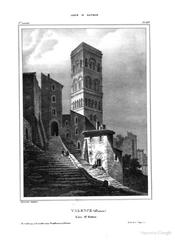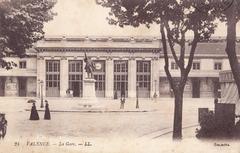Abbaye De Saint-Ruf-Hors-Les-Murs: Visiting Hours, Tickets, and Historical Significance in Valence, France
Date: 14/06/2025
Introduction
Nestled in the heart of Valence, France, the Abbaye de Saint-Ruf-hors-les-murs is a remarkable testament to the region’s medieval monastic culture, religious reform, and architectural evolution. Founded in the early 11th century by the Order of Saint Ruf, the abbey’s influence extended across southern France and beyond, shaping monastic discipline, theological scholarship, and pilgrimage traditions, especially along the Santiago de Compostela route. Today, its surviving structures—most notably the monumental portal and the Temple Saint-Ruf—invite visitors to explore a layered history that has endured wars, revolutions, and modern transformations.
This comprehensive guide covers the abbey’s historical background, architectural highlights, visiting hours, ticketing information, accessibility, and travel tips. Whether you are a history enthusiast, architecture lover, or a traveler seeking cultural enrichment, the Abbaye de Saint-Ruf offers a unique journey through centuries of spiritual devotion and heritage.
For more information, refer to the Valence Tourist Office, Musée de Valence, and Ministère de la Culture.
Historical Overview and Cultural Significance
Foundation and Early Growth
The Order of Saint Ruf was established in 1039, when a group of clerics settled in a ruined church near Avignon, supported by Bishop Benoît Iᵉʳ. The order became renowned for its commitment to clergy reform and monastic discipline, rapidly founding daughter houses across Alsace, Lorraine, and Languedoc.
Move to Valence and Medieval Flourishing
Conflict with Avignon’s cathedral chapter prompted the order to relocate its motherhouse to Valence. Positioned on the Rhône and along key pilgrimage routes, Valence offered both strategic and spiritual advantages. The abbey soon grew into a religious and cultural powerhouse, acquiring properties such as the Île de l’Épervière and establishing a network of dependent priories.
Architectural Evolution
The abbey’s structures, built between the 13th and 15th centuries, reflect the transition from Romanesque to Gothic styles. Surviving features include robust vaulted ceilings, sculpted capitals, and a monumental 18th-century portal—now the entrance to Parc Saint-Ruf. Although the original cloisters and monastic buildings were largely destroyed, the impressive façade and staircase of the abbatial hotel remain.
Historical Turmoil and Adaptive Reuse
The abbey suffered significant damage during the French Wars of Religion in the 16th century and was further secularized during the French Revolution. Its church, repurposed for Protestant worship in 1806, became the first Protestant temple in Valence. WWII bombings destroyed much of the complex, but key architectural elements survive, protected as Monuments Historiques and displayed in the Musée de Valence.
Key Architectural and Artistic Highlights
Romanesque and Gothic Heritage
The abbey’s remaining structures showcase Romanesque solidity—thick limestone walls, rounded arches, and intricate capitals—with later Gothic additions such as pointed arches and ribbed vaulting. The monumental portal and sculpted capitals, adorned with biblical and symbolic motifs, stand as exemplars of medieval craftsmanship (Base Mérimée; Corpus des Églises Romanes).
Artistic Legacy
Carved stonework, polychrome decoration, and surviving liturgical furnishings underscore the abbey’s artistic significance. Some choir stalls, reliquaries, and illuminated manuscripts are preserved at the Musée de Valence and in national collections (Gallica BnF).
The Temple Saint-Ruf
After the original abbey’s destruction, the priory chapel of Saint-Jacques became the new abbey church. Now known as the Temple Saint-Ruf, its baroque interior features elaborate stucco garlands, a gilded “gloire,” original wood paneling, and stained glass windows. It also houses the tomb of General Jean-Étienne Championnet (Guide Tourisme France; Musée Protestant).
Visitor Information: Hours, Tickets, and Access
Abbaye de Saint-Ruf Remnants and Parc Saint-Ruf
- Access: The monumental portal and surviving abbey structures are part of Parc Saint-Ruf. As of June 2025, Parc Saint-Ruf remains closed due to ground subsidence and archaeological research. Check the Valence Tourist Office for updates.
- Entrance Fee: Free for exterior remains.
- Accessibility: Partial; uneven terrain may limit access for those with reduced mobility.
Temple Saint-Ruf (2 rue Saint-James)
- Visiting Hours: Open to the public Tuesdays from 16:00–19:00, with extended hours in summer and during special events such as the European Heritage Days (Journées du Patrimoine).
- Admission: Free, no reservation required for regular visits or special events.
- Accessibility: Wheelchair accessible.
- Guided Tours: Available during heritage events and by prior arrangement. Contact the Valence Tourist Office for details.
Getting There and Parking
- Location: Central Valence, walking distance from the Valence-Ville train station.
- By Car: Public parking available near the abbey and city center.
- By Public Transport: Served by local buses and trains.
Travel Tips and Best Visiting Times
- When to Visit: Spring and autumn offer mild weather and fewer crowds. Special events like European Heritage Days in September provide enhanced access and guided tours.
- Photography: The abbey’s exterior, portal, and Temple Saint-Ruf’s baroque interior offer excellent photographic opportunities. Please respect restrictions during religious services.
- Accessibility Caution: Wear comfortable shoes; some areas have uneven surfaces.
- Combine Visits: Pair your abbey visit with nearby attractions like Valence Cathedral and the Musée de Valence for a full day of cultural discovery.
Nearby Attractions
- Valence Cathedral: Gothic architecture, a short walk from the abbey.
- Musée de Valence: Archaeological and art collections, including abbey artifacts.
- Parc Jouvet: Historic park ideal for relaxation post-visit.
- Historic City Center: Explore Renaissance streets, markets, and local cuisine.
FAQs
Q: What are the visiting hours for Abbaye de Saint-Ruf?
A: Outdoor remains are generally accessible during daylight hours, but Parc Saint-Ruf is currently closed. Temple Saint-Ruf is open Tuesdays 16:00–19:00 and during special events. Check with local tourism offices for updates.
Q: Is there an entrance fee?
A: No fee for exterior remains or Temple Saint-Ruf. Guided tours during events may require booking.
Q: Are guided tours available?
A: Yes, especially during heritage events and by arrangement via the Valence Tourist Office.
Q: Is the abbey accessible for reduced mobility visitors?
A: Temple Saint-Ruf is fully accessible; the abbey’s outdoor remains have partial accessibility.
Q: Can I take photos?
A: Yes, except during religious services in Temple Saint-Ruf.
Conclusion
The Abbaye de Saint-Ruf-hors-les-murs and Temple Saint-Ruf stand as enduring symbols of Valence’s spiritual, artistic, and architectural legacy. By planning your visit around guided tours, heritage events, and quieter months, you’ll gain a deeper appreciation of the abbey’s rich history. Combine your exploration with nearby sites and local cuisine for a rewarding cultural experience.
For the most current visiting hours, ticket information, and event schedules, consult the Valence Tourist Office and consider downloading the Audiala app for digital guides and updates. Embrace the opportunity to connect with Valence’s living heritage.

